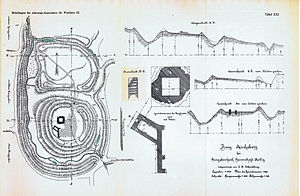Ascheberg Castle
| Ascheberg Castle | ||
|---|---|---|
|
Schmedding excavation plan (published 1903). |
||
| Creation time : | Medieval | |
| Castle type : | Hilltop castle | |
| Conservation status: | Burgstall | |
| Construction: | Quarry stone | |
| Place: | Steinfurt -Burgsteinfurt | |
| Geographical location | 52 ° 9 '15.2 " N , 7 ° 21' 31.8" E | |
| Height: | 77.4 m above sea level NHN | |
|
|
||
The Castle Mountain ash is the ruins of a medieval hilltop castle in Steinfurt in North Rhine-Westphalia . In the Middle Ages, the castle was the ancestral seat of the noble family of the Lords of Ascheberg . The Carolingian complex was abandoned in the 12th century.
Location and topography
The ruin is located in the Burgsteinfurt district at 77.4 m above sea level. NHN on the northern slope of the Hollichen Höhe about 1500 meters northeast of Burgsteinfurt Castle . Field names in the immediate vicinity of the ruins still indicate the Ascheberg house today.
Research history
The sources on Ascheberg Castle are very poor. No information has been passed on when the castle was built or used, which is why we can only expect findings on this from archaeological research .
The complex was partially archaeologically examined in 1900 by the Antiquities Commission for Westphalia under the direction of building officer Johann Heinrich Schmedding and at the suggestion of the Burgsteinfurt grammar school teacher Karl Georg Döhmann.
It was found that the castle was a two-part, roughly B-shaped complex that took up an area of around 160 × 100 meters and was surrounded by a ditch-wall system. The courtyards of the higher-lying southern main castle and the lower-lying northern lower castle each offered a usable area of around 40 × 40 meters.
On the southern courtyard Schmedding was the main castle with a palace and a castle keep evidence. The courtyard was paved with flat stone slabs. A little to the northwest from the center of the courtyard, but still central, was the keep with a polygonal outer and a square inner plan. The foundations consist of mortared local quarry stone and are 2.50 meters thick. They have a clear dimension of 4 × 4 meters.
To the south of the keep, Schmedding discovered the foundation of a stone building that he identified as the Palas. He was able to follow the foundation over a length of 11 meters. The quarry stone wall was 0.70 meters thick and also consisted of local mortar quarry stone. As corner stones, blocks made from Bentheim sandstone were used.
It is still unclear where the access to the castle was located.
The outer bailey with the farm buildings is believed to be in the lower northern part of the complex. Excavation results to support this assumption are not available.
The excavation results indicate that the facility was built in the Carolingian era and burned down in the 12th century.
This coincides with the report from a chronicle of the Johanniter coming in Steinfurt from the 15th century, according to which the castle was destroyed around 1164 in a feud between the lords of Ascheberg and the lords of Steinfurt . The original documentation of the Schmedding excavation has not been preserved. In 2010, on the occasion of the project of the city of Steinfurt to make the ground monument accessible to the public, the LWL archeology for Westphalia was re-excavated , which confirmed Schmedding's excavation results.
Public and monument protection
The ruin has been accessible to the public via information boards and a system of paths since 2013. The foundations, which are protected in the ground but known from the excavation of 1900, were also marked above ground by 0.5 meter high wire ballast boxes. The NRW Foundation funded this measure with € 24,000.
The area of the castle ruins is a ground monument according to the law for the protection and maintenance of monuments in the state of North Rhine-Westphalia (Monument Protection Act - DSchG NW) . Investigations and targeted collection of finds are subject to approval, and accidental finds are reported to the monument authorities.
literature
- Karl Georg Döhmann: The nobles of Ascheberg and their castle near Burgsteinfurt. Journal for patriotic history and antiquity, issue 59, 1901. pp. 214–226.
- Christoph Grünewald : On the trail of old excavations - Investigations of Ascheberg Castle near Burgsteinfurt. In: Archeology in Westphalia-Lippe 2010. Langenweißbach 2011. pp. 142–145.
- Gerard Jentgens: An almost forgotten treasure. Ascheberg Castle near Burgsteinfurt. In: Our circle. Issue 20, Steinfurt 2007. pp. 173-177.
- Johann Heinrich Schmedding: The Ascheberg Castle near Burgsteinfurt. In: Communications of the Antiquities Commission for Westphalia . Issue 3, Münster 1903. pp. 127-131, plate XXI.
Web links
- Ascheberg Castle shines again. Site of the home club Burgsteinfurt.
- Historical reconstruction drawing

